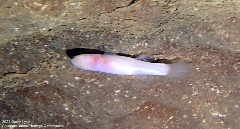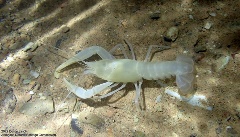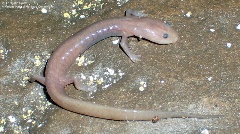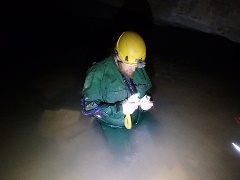I recently accompanied biologists from the US Fish and Wildlife Service (USFWS) Arkansas Ecological Services Field Office during surveys for federally listed cave species in Arkansas. We visited two crucially important sites – Logan Cave National Wildlife Refuge in Benton County and the Arkansas Natural Heritage Commission’s (ANHC) Hell Creek Cave Natural Area in Stone County, looking for the threatened Ozark Cavefish (Troglichtys rosae), the endangered Benton County Cave Crayfish (Cambarus aculabrum), and the endangered Hell Creek Cave Crayfish (Cambarus zophonastes). The biennial survey team included partners from the Arkansas Game and Fish Commission (AGFC) and The Nature Conservancy (TNC). These surveys are crucial for monitoring the persistence of these species.
 Logan Cave National Wildlife Refuge is home to both the Ozark Cavefish and the Benton County Cave Crayfish. The Ozark Cavefish, federally listed as a threatened species since 1984, is a small, eyeless fish that reaches a maximum length of about two inches. Its body is depigmented and translucent; blood flowing through vessels beneath the skin give its pale skin a pinkish tinge. It is found only in cave and karst systems on the Springfield Plateau region of the Ozark Highlands and is rare throughout its range. In Arkansas, it is confined to a handful of known locations in Benton and Washington counties. Logan Cave is home to one of the largest known populations of this species.
Logan Cave National Wildlife Refuge is home to both the Ozark Cavefish and the Benton County Cave Crayfish. The Ozark Cavefish, federally listed as a threatened species since 1984, is a small, eyeless fish that reaches a maximum length of about two inches. Its body is depigmented and translucent; blood flowing through vessels beneath the skin give its pale skin a pinkish tinge. It is found only in cave and karst systems on the Springfield Plateau region of the Ozark Highlands and is rare throughout its range. In Arkansas, it is confined to a handful of known locations in Benton and Washington counties. Logan Cave is home to one of the largest known populations of this species.
The Ozark Cavefish feeds on small cave-dwelling crustaceans and sometimes larger prey such as small crayfish or salamanders. Its low metabolism allows it to feed much less frequently than most fish species and it spends much of its time motionless in the water column. While it lacks eyes, it has a well-developed lateral line system that allows it to detect the motion of prey or predator movements. Like many cave species, Ozark Cavefish exhibit low reproductive potential, with only a small percentage of a population being sexually mature or spawning each year. It is thought that this species may be very long-lived, particularly when compared to other small fish species.
 Another denizen of Logan Cave is the even rarer Benton County Cave Crayfish, which can be found in the same aquatic habitats as Ozark Cavefish. First described in 1987 and federally listed as an endangered species by 1993, the Benton County Cave Crayfish is unpigmented with reduced, rudimentary eyes and reaches a maximum length of around 1.8 inches. It is one of the rarest of the approximately 60 crayfish species that call Arkansas home. The species is known only from three cave systems in Benton County, Arkansas, although individuals have been expelled from groundwater to the surface during high-water events at two other sites, one in Washington County and one just across the state line in McDonald County, Missouri. It is thought that destruction of habitat and past human disturbance may have led to a decline in this species, making protection of sites with known populations of paramount importance to its continued existence. Habitat degradation from groundwater pollution remains one of the most serious threats to the Benton County Cave Crayfish. Both the Ozark Cavefish and Benton County Cave Crayfish occur in northwest Arkansas, the most rapidly urbanizing area of the state. This brings with it a host of threats to rare species and challenges to their protection.
Another denizen of Logan Cave is the even rarer Benton County Cave Crayfish, which can be found in the same aquatic habitats as Ozark Cavefish. First described in 1987 and federally listed as an endangered species by 1993, the Benton County Cave Crayfish is unpigmented with reduced, rudimentary eyes and reaches a maximum length of around 1.8 inches. It is one of the rarest of the approximately 60 crayfish species that call Arkansas home. The species is known only from three cave systems in Benton County, Arkansas, although individuals have been expelled from groundwater to the surface during high-water events at two other sites, one in Washington County and one just across the state line in McDonald County, Missouri. It is thought that destruction of habitat and past human disturbance may have led to a decline in this species, making protection of sites with known populations of paramount importance to its continued existence. Habitat degradation from groundwater pollution remains one of the most serious threats to the Benton County Cave Crayfish. Both the Ozark Cavefish and Benton County Cave Crayfish occur in northwest Arkansas, the most rapidly urbanizing area of the state. This brings with it a host of threats to rare species and challenges to their protection.
 The Hell Creek Cave Crayfish, endemic to Arkansas, was first described in 1964 and listed as a federally endangered species in 1987. It looks quite similar to the previous species, although it has a number of morphological (body structure) differences, attains a larger maximum size (up to around 3 inches) and occurs in a different part of the state. This species was originally thought to be a single-cave endemic, found only in Stone County’s Hell Creek Cave (protected by the ANHC as Hell Creek Cave Natural Area since 1985) but was subsequently found in one other cave, as well as a third known site where individuals have occasionally been expelled from groundwater to the surface during high flow events. Although this species occurs in a less populated and impacted area of the state than the previous two, it may still face threats to groundwater quality. While the natural area protects the population in Hell Creek Cave, other populations are less protected.
The Hell Creek Cave Crayfish, endemic to Arkansas, was first described in 1964 and listed as a federally endangered species in 1987. It looks quite similar to the previous species, although it has a number of morphological (body structure) differences, attains a larger maximum size (up to around 3 inches) and occurs in a different part of the state. This species was originally thought to be a single-cave endemic, found only in Stone County’s Hell Creek Cave (protected by the ANHC as Hell Creek Cave Natural Area since 1985) but was subsequently found in one other cave, as well as a third known site where individuals have occasionally been expelled from groundwater to the surface during high flow events. Although this species occurs in a less populated and impacted area of the state than the previous two, it may still face threats to groundwater quality. While the natural area protects the population in Hell Creek Cave, other populations are less protected.
 During surveys of these sites, our team also observed and collected data on other cave-dwelling species. These included the Southern Grotto Salamander (Eurycea braggi), which has a very unusual life cycle. This species begins its life as a surface-dwelling aquatic larva with functioning eyes and dark pigment and is found in springs and small streams. Eventually it migrates underground as it metamorphoses into an adult with reduced pigmentation and non-functional eyes fused shut with skin. While not listed as a federally endangered or threatened species, it is considered as a species of greatest conservation need (SGCN) by the AGFC and tracked as an S3 (vulnerable) species in Arkansas by the ANHC.
During surveys of these sites, our team also observed and collected data on other cave-dwelling species. These included the Southern Grotto Salamander (Eurycea braggi), which has a very unusual life cycle. This species begins its life as a surface-dwelling aquatic larva with functioning eyes and dark pigment and is found in springs and small streams. Eventually it migrates underground as it metamorphoses into an adult with reduced pigmentation and non-functional eyes fused shut with skin. While not listed as a federally endangered or threatened species, it is considered as a species of greatest conservation need (SGCN) by the AGFC and tracked as an S3 (vulnerable) species in Arkansas by the ANHC.
 The survey team also observed bat species such as the Tricolored Bat (Perimyotis subflavus) which use these caves as important hibernation sites during the winter. We found a Dark Fishing Spider (Dolomedes tenebrosus) lurking on the walls of Hell Creek Cave; while not a cave obligate, this is a species often found in the quiet, dark recesses of environments such as caves. We even encountered some surface-dwelling crayfish species that had infiltrated the cave environment, including a Hubbs’ Crayfish (Cambarus hubbsi), which stood in sharp contrast to its unpigmented relatives with its bright green hue, functional eyes, stouter claws, and larger, more robust build. The Hubbs’ Crayfish is another SGCN species considered vulnerable in Arkansas.
The survey team also observed bat species such as the Tricolored Bat (Perimyotis subflavus) which use these caves as important hibernation sites during the winter. We found a Dark Fishing Spider (Dolomedes tenebrosus) lurking on the walls of Hell Creek Cave; while not a cave obligate, this is a species often found in the quiet, dark recesses of environments such as caves. We even encountered some surface-dwelling crayfish species that had infiltrated the cave environment, including a Hubbs’ Crayfish (Cambarus hubbsi), which stood in sharp contrast to its unpigmented relatives with its bright green hue, functional eyes, stouter claws, and larger, more robust build. The Hubbs’ Crayfish is another SGCN species considered vulnerable in Arkansas.
 These awe-inspiring underground ecosystems are some of the most unique in Arkansas. The protection of sites such as Hell Creek Cave and Logan Cave plays a critical role in ensuring the survival of an irreplaceable component of our state’s natural heritage.
These awe-inspiring underground ecosystems are some of the most unique in Arkansas. The protection of sites such as Hell Creek Cave and Logan Cave plays a critical role in ensuring the survival of an irreplaceable component of our state’s natural heritage.
Photos (click individual photo for larger image):
Photo 1 — Ozark Cavefish (Troglichthys rosae) at Logan Cave National Wildlife Refuge. Photo by Dustin Lynch.
Photo 2 — Benton County Cave Crayfish (Cambarus aculabrum) at Logan Cave National Wildlife Refuge. Photo by Dustin Lynch.
Photo 3 — Hell Creek Cave Crayfish (Cambarus zophonastes) at Hell Creek Cave Natural Area. Photo by Dustin Lynch.
 Photo 4 — Southern Grotto Salamander (Eurycea braggi) at Slippery Hollow Natural Area. Photo by Dustin Lynch.
Photo 4 — Southern Grotto Salamander (Eurycea braggi) at Slippery Hollow Natural Area. Photo by Dustin Lynch.
Photo 5 — Dark Fishing Spider (Dolomedes tenebrosus) at Hell Creek Cave Natural Area. Photo by Dustin Lynch.
Photo 6 — Hubbs' Crayfish (Cambarus hubbsi) at Hell Creek Cave Natural Area. Photo by Dustin Lynch.
Main Photo — A cave survey at Logan Cave National Wildlife Refuge. Photo by Dustin Lynch.
Bottom Photo — ANHC Aquatic Ecologist Dustin Lynch during a survey at Hell Creek Cave Natural Area. Photo by Emily Roberts.
 Logan Cave National Wildlife Refuge is home to both the Ozark Cavefish and the Benton County Cave Crayfish. The Ozark Cavefish, federally listed as a threatened species since 1984, is a small, eyeless fish that reaches a maximum length of about two inches. Its body is depigmented and translucent; blood flowing through vessels beneath the skin give its pale skin a pinkish tinge. It is found only in cave and karst systems on the Springfield Plateau region of the Ozark Highlands and is rare throughout its range. In Arkansas, it is confined to a handful of known locations in Benton and Washington counties. Logan Cave is home to one of the largest known populations of this species.
Logan Cave National Wildlife Refuge is home to both the Ozark Cavefish and the Benton County Cave Crayfish. The Ozark Cavefish, federally listed as a threatened species since 1984, is a small, eyeless fish that reaches a maximum length of about two inches. Its body is depigmented and translucent; blood flowing through vessels beneath the skin give its pale skin a pinkish tinge. It is found only in cave and karst systems on the Springfield Plateau region of the Ozark Highlands and is rare throughout its range. In Arkansas, it is confined to a handful of known locations in Benton and Washington counties. Logan Cave is home to one of the largest known populations of this species. The Ozark Cavefish feeds on small cave-dwelling crustaceans and sometimes larger prey such as small crayfish or salamanders. Its low metabolism allows it to feed much less frequently than most fish species and it spends much of its time motionless in the water column. While it lacks eyes, it has a well-developed lateral line system that allows it to detect the motion of prey or predator movements. Like many cave species, Ozark Cavefish exhibit low reproductive potential, with only a small percentage of a population being sexually mature or spawning each year. It is thought that this species may be very long-lived, particularly when compared to other small fish species.
 Another denizen of Logan Cave is the even rarer Benton County Cave Crayfish, which can be found in the same aquatic habitats as Ozark Cavefish. First described in 1987 and federally listed as an endangered species by 1993, the Benton County Cave Crayfish is unpigmented with reduced, rudimentary eyes and reaches a maximum length of around 1.8 inches. It is one of the rarest of the approximately 60 crayfish species that call Arkansas home. The species is known only from three cave systems in Benton County, Arkansas, although individuals have been expelled from groundwater to the surface during high-water events at two other sites, one in Washington County and one just across the state line in McDonald County, Missouri. It is thought that destruction of habitat and past human disturbance may have led to a decline in this species, making protection of sites with known populations of paramount importance to its continued existence. Habitat degradation from groundwater pollution remains one of the most serious threats to the Benton County Cave Crayfish. Both the Ozark Cavefish and Benton County Cave Crayfish occur in northwest Arkansas, the most rapidly urbanizing area of the state. This brings with it a host of threats to rare species and challenges to their protection.
Another denizen of Logan Cave is the even rarer Benton County Cave Crayfish, which can be found in the same aquatic habitats as Ozark Cavefish. First described in 1987 and federally listed as an endangered species by 1993, the Benton County Cave Crayfish is unpigmented with reduced, rudimentary eyes and reaches a maximum length of around 1.8 inches. It is one of the rarest of the approximately 60 crayfish species that call Arkansas home. The species is known only from three cave systems in Benton County, Arkansas, although individuals have been expelled from groundwater to the surface during high-water events at two other sites, one in Washington County and one just across the state line in McDonald County, Missouri. It is thought that destruction of habitat and past human disturbance may have led to a decline in this species, making protection of sites with known populations of paramount importance to its continued existence. Habitat degradation from groundwater pollution remains one of the most serious threats to the Benton County Cave Crayfish. Both the Ozark Cavefish and Benton County Cave Crayfish occur in northwest Arkansas, the most rapidly urbanizing area of the state. This brings with it a host of threats to rare species and challenges to their protection. The Hell Creek Cave Crayfish, endemic to Arkansas, was first described in 1964 and listed as a federally endangered species in 1987. It looks quite similar to the previous species, although it has a number of morphological (body structure) differences, attains a larger maximum size (up to around 3 inches) and occurs in a different part of the state. This species was originally thought to be a single-cave endemic, found only in Stone County’s Hell Creek Cave (protected by the ANHC as Hell Creek Cave Natural Area since 1985) but was subsequently found in one other cave, as well as a third known site where individuals have occasionally been expelled from groundwater to the surface during high flow events. Although this species occurs in a less populated and impacted area of the state than the previous two, it may still face threats to groundwater quality. While the natural area protects the population in Hell Creek Cave, other populations are less protected.
The Hell Creek Cave Crayfish, endemic to Arkansas, was first described in 1964 and listed as a federally endangered species in 1987. It looks quite similar to the previous species, although it has a number of morphological (body structure) differences, attains a larger maximum size (up to around 3 inches) and occurs in a different part of the state. This species was originally thought to be a single-cave endemic, found only in Stone County’s Hell Creek Cave (protected by the ANHC as Hell Creek Cave Natural Area since 1985) but was subsequently found in one other cave, as well as a third known site where individuals have occasionally been expelled from groundwater to the surface during high flow events. Although this species occurs in a less populated and impacted area of the state than the previous two, it may still face threats to groundwater quality. While the natural area protects the population in Hell Creek Cave, other populations are less protected. During surveys of these sites, our team also observed and collected data on other cave-dwelling species. These included the Southern Grotto Salamander (Eurycea braggi), which has a very unusual life cycle. This species begins its life as a surface-dwelling aquatic larva with functioning eyes and dark pigment and is found in springs and small streams. Eventually it migrates underground as it metamorphoses into an adult with reduced pigmentation and non-functional eyes fused shut with skin. While not listed as a federally endangered or threatened species, it is considered as a species of greatest conservation need (SGCN) by the AGFC and tracked as an S3 (vulnerable) species in Arkansas by the ANHC.
During surveys of these sites, our team also observed and collected data on other cave-dwelling species. These included the Southern Grotto Salamander (Eurycea braggi), which has a very unusual life cycle. This species begins its life as a surface-dwelling aquatic larva with functioning eyes and dark pigment and is found in springs and small streams. Eventually it migrates underground as it metamorphoses into an adult with reduced pigmentation and non-functional eyes fused shut with skin. While not listed as a federally endangered or threatened species, it is considered as a species of greatest conservation need (SGCN) by the AGFC and tracked as an S3 (vulnerable) species in Arkansas by the ANHC.  The survey team also observed bat species such as the Tricolored Bat (Perimyotis subflavus) which use these caves as important hibernation sites during the winter. We found a Dark Fishing Spider (Dolomedes tenebrosus) lurking on the walls of Hell Creek Cave; while not a cave obligate, this is a species often found in the quiet, dark recesses of environments such as caves. We even encountered some surface-dwelling crayfish species that had infiltrated the cave environment, including a Hubbs’ Crayfish (Cambarus hubbsi), which stood in sharp contrast to its unpigmented relatives with its bright green hue, functional eyes, stouter claws, and larger, more robust build. The Hubbs’ Crayfish is another SGCN species considered vulnerable in Arkansas.
The survey team also observed bat species such as the Tricolored Bat (Perimyotis subflavus) which use these caves as important hibernation sites during the winter. We found a Dark Fishing Spider (Dolomedes tenebrosus) lurking on the walls of Hell Creek Cave; while not a cave obligate, this is a species often found in the quiet, dark recesses of environments such as caves. We even encountered some surface-dwelling crayfish species that had infiltrated the cave environment, including a Hubbs’ Crayfish (Cambarus hubbsi), which stood in sharp contrast to its unpigmented relatives with its bright green hue, functional eyes, stouter claws, and larger, more robust build. The Hubbs’ Crayfish is another SGCN species considered vulnerable in Arkansas. These awe-inspiring underground ecosystems are some of the most unique in Arkansas. The protection of sites such as Hell Creek Cave and Logan Cave plays a critical role in ensuring the survival of an irreplaceable component of our state’s natural heritage.
These awe-inspiring underground ecosystems are some of the most unique in Arkansas. The protection of sites such as Hell Creek Cave and Logan Cave plays a critical role in ensuring the survival of an irreplaceable component of our state’s natural heritage.Photos (click individual photo for larger image):
Photo 1 — Ozark Cavefish (Troglichthys rosae) at Logan Cave National Wildlife Refuge. Photo by Dustin Lynch.
Photo 2 — Benton County Cave Crayfish (Cambarus aculabrum) at Logan Cave National Wildlife Refuge. Photo by Dustin Lynch.
Photo 3 — Hell Creek Cave Crayfish (Cambarus zophonastes) at Hell Creek Cave Natural Area. Photo by Dustin Lynch.
 Photo 4 — Southern Grotto Salamander (Eurycea braggi) at Slippery Hollow Natural Area. Photo by Dustin Lynch.
Photo 4 — Southern Grotto Salamander (Eurycea braggi) at Slippery Hollow Natural Area. Photo by Dustin Lynch.
Photo 5 — Dark Fishing Spider (Dolomedes tenebrosus) at Hell Creek Cave Natural Area. Photo by Dustin Lynch.
Photo 6 — Hubbs' Crayfish (Cambarus hubbsi) at Hell Creek Cave Natural Area. Photo by Dustin Lynch.
Main Photo — A cave survey at Logan Cave National Wildlife Refuge. Photo by Dustin Lynch.
Bottom Photo — ANHC Aquatic Ecologist Dustin Lynch during a survey at Hell Creek Cave Natural Area. Photo by Emily Roberts.
